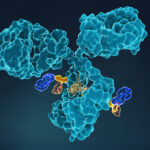
Chief Executive Officer
Tune Therapeutics
Epigenome editing has undergone something of a renaissance in recent years, but scientists have been using basic gene-modulation tools for much longer. Two of the earliest were transcriptional regulators like zinc-finger proteins and transcription activator-like effectors. Their ability to turn genes on and off was what drew Charles Gersbach, PhD, to the field initially. He was particularly interested in modulating genes to try to rejuvenate diseased or aging tissues, among other applications. When he started working with zinc finger proteins in 2006, “no way did I think that CRISPR was going to happen six, seven years later, and the field was going to take off.”
Today, Gersbach continues to work with editing technologies like CRISPR in his laboratory at Duke University. For example, a 2023 Nature Genetics publication describes work from the Gersbach lab that used CRISPR screens to identify regulatory genes that could be targeted to improve cancer T-cell therapies. Looking back over his decades in the space, he sees the timing of his early interest as fortuitous. “We were very much in the right place at the right time” to work in a lot of different areas, he reflected. Still, he remained drawn to the core idea of reprogramming the epigenome to target complex and common diseases.
Gersbach’s interest led him to co-found epigenetic editing company Tune Therapeutics in 2021 together with noted genome editing expert and advocate, Fyodor Urnov, PhD, professor of molecular and cell biology at the University of California, Berkeley and director of technology and translation at the Innovative Genomics Institute. Foundational research from both Gersbach and Urnov forms the basis for Tune’s TEMPO epi-editing platform.
“Epigenome editing is incredibly powerful. I believe it’s the most powerful modality that we have to control cell biology,” he says. “If you can activate and repress, if you can choose whether you want that to be a transient effect or a sustained effect, it really gives you control over cell biology, unlike any other technology that I’m aware of.”
And now those efforts may start to bear clinical fruit as three leading developers of epigenome editing therapies are moving their lead assets into human clinical trials after promising preclinical studies.
Tune is now enrolling patients in its RHYTHM trial, which will test the company’s epigenetic silencing therapy for chronic Hepatitis B virus (HBV) delivered using lipid nanoparticles. The treatment epigenetically silences viral HBV intDNA and cccDNA, which are necessary for sustained HBV infection. In January 2025, Tune raised $175 million to further develop its clinical-stage therapy, dubbed “Tune-401,” as well as several additional gene, cell, and regenerative therapy programs already underway. Akira Matsuno, another Tune co-founder (and president and CFO), tells GEN that the company’s clinical trial applications in New Zealand and Hong Kong were also approved in early 2025. Previously, the company presented data at the annual meeting of the American Society of Gene & Cell Therapy in support of its therapy’s efficacy in non-human primates (NHPs). As there are no naturally occurring larger animal models of HBV, they used their epi-repressor to achieve durable suppression of PCSK9 in NHPs, accompanied by durable LDL cholesterol levels following a single treatment.
Matsuno also says that while the company’s primary focus for now is HBV, it is evaluating other potential applications. The ability to do targeted gene modulation without DNA damage “supports our opportunity to target common diseases,” he says. “Further, we could consider multiplexing genes or gene networks to ameliorate or treat common diseases.”
Ambitions for tiny epigenetic editors

Head of Platform
Epicrispr Biotechnologies
Part of what makes Epicrispr Biotechnologies’ approach to epigenetics unique is the size of its editors. As Daniel Hart, PhD, Epicrispr’s head of platform, explains, many enzymes that naturally write, read, and erase epigenetic marks are quite large. That fact, coupled with Cas proteins’ large size, “precludes their easy application to protein therapy.” From the beginning, “we deliberately built a platform where all the component pieces are very small whilst retaining or improving on activity.”
Founded in 2019, Epicrispr commercializes CRISPR-based technologies from the lab of Lei Stanley Qi, PhD, a bioengineer at Stanford University. The modified form of Cas12f it uses in therapies is half the size of the Cas9 and Cas12a proteins. Importantly, “our Cas molecules are non-bacterial,” adds Amber Salzman, Epicrispr’s CEO. This is meaningful when thinking about patient safety and applying these treatments in therapeutic settings because it reduces the risk of immunogenicity.

Chief Executive Officer
Epicrispr Biotechnologies
This past March, Epicrispr announced plans to initiate human trials for its lead asset EPI 321. Targeting the neuromuscular disorder facioscapulohumeral muscular dystrophy (FSHD), the therapy uses multiple modulators to repress expression of the double homeobox 4 (DUX4) gene. Building on findings from existing studies in FSHD patients that closely link disease severity to hypomethylation status, Epicrispr’s therapy methylates its target to prevent DUX4 from leaking out and poisoning muscle cells. The company disclosed in March that it would dose patients one at a time in monthly intervals, along with muscle biopsies performed at different time points. It also has an agreement with the muscle health analytics company Springbok Analytics to use its proprietary artificial intelligence-based muscle MRI imaging and analysis capabilities in the trial.
While its first therapy works by suppressing a gene, Epicrispr also has modulators that activate genes. Salzman is particularly excited about the activators the company has in its portfolio because of their potential to target diseases that may be difficult to address directly with gene therapies. “The fact that we can activate is huge,” she says, because “there [are] many diseases where the gene you would like to put in is way too big to fit inside an AAV, but there are compensatory genes that could act on its behalf.”
For example, in vitro and animal model studies in Duchenne muscular dystrophy show that microdystrophin, a short, functional version of the larger dystrophin protein, can work as a gene therapy, Hart notes. However, “there is an endogenous protein called utrophin that is 80% identical, but too big to fit into classical gene therapy delivery vehicles. What if you could turn that [gene] on?”—it’s just one of many instances that the technology is well suited to address.
But for now, the focus is on moving EPI 321 forward. Early mechanistic data from clinical trials could be available by early next year which provide evidence of the clinical benefits of the treatment. “We’re doing muscle biopsies at baseline in three months, [so we] will be able to demonstrate that we have the target engagement we wanted and that we are in fact methylating the region as we did in preclinical models,” Salzman says.
Besides FSHD and DMD, Epic is pursuing a treatment for autosomal dominant retinitis pigmentosa 4 (AdRP4), a disorder linked to mutations in the rhodopsin (RHO) gene. The therapeutic, delivered using a single AAV vector, is intended to work on the more than 140 RHO mutations associated with AdRP4. Although its primary delivery mode is AAVs, Epicrispr can use several other types of delivery vehicles. For example, the company has proof-of-concept data demonstrating successful delivery using LNPs in a humanized mouse model of familial hypercholesterolemia.
With FSHD, because the target is skeletal muscle, “we wanted to use a tried and tested approach,” Salman says. She pointed to the success of therapies like Zolgensma, a therapy for spinal muscular atrophy in children that is delivered using an AAV vector. “As new technologies come out, we can always do next-gen type indications,” but with AAVs, “at least we can prove that we can really get to the root cause of the disease.”
Epigenetic merger hits trials
Launched in December 2024, nChroma Bio may be a newcomer to the epigenome editing space, but its technology is not. The new company was formed when Chroma Medicine and Nvelop Therapeutics merged, bringing their epigenetic editing and in vivo delivery technologies together under a single banner.

Chief Executive Officer
nChroma Bio
Integrating technologies and personnel from two separate companies is always challenging, even when the companies are complementary. But it is one that nChroma has navigated well, says CEO Jeff Walsh. In the intervening months, the company has kept its therapy development programs on track and retains enough capital to keep making progress through 2027. Overall, “we feel like we’re in a great position,” he says.
One goal for this year was to file a clinical trial application for CRMA-1001, an epigenetic editing therapy for chronic hepatitis B and hepatitis D delivered using LNPs. If all goes well, the first patients to get the treatment will be dosed early next year. When they get underway, Phase I / II trials for nChroma’s lead asset will take place in sites outside the United States, with further trials in the U.S. depending on patient outcomes of those initial trials.
Meanwhile, other initiatives are moving forward, including discussions around a potential academic partnership focused on using AAVs to transport epigenetic editors across the blood-brain barrier, opening up the possibility of targeting diseases of the central nervous system. Other preclinical programs target hematopoietic stem cells, B cells, and T cells using engineered virus-like particles. nChroma has ongoing NHP studies to optimize these programs.

Chief Scientific Officer
nChroma Bio
“We’re really bringing together epigenetic editors” that “have a distinct value of not cutting or nicking the DNA, but potently and durably silencing the genes in a very specific way,” and a novel delivery technology, “which has the ability to avoid the liver but efficiently target these cells that we’re interested in,” says Melissa Bonner, PhD, the company’s CSO.
nChroma is particularly excited about the results from using its epigenetic silencers to target PCSK9. This is partly due to broader interest in targeting PCSK9 and regulating low-density lipoprotein cholesterol, but the numbers are also a testament to the potency of nChroma’s technology. “In our non-human primate study, when we use PCSK9 as our target of interest,” Bonner says, “we see exquisite potency at very low doses. We are getting saturating silencing of PCSK9 at 0.5 mg/kg,” which corresponds to about a three to six-fold improvement over some previously reported studies using the same animal model.

Observing the desired effect at such doses is both impressive and encouraging from Walsh’s perspective because “it suggests that a substantially lower dose could have the same effect,” he says. And “if we can go lower than that, there is a potential that we [can] take any concern of an LNP-delivered product off the table. We’ll be at such low doses that it should be inconsequential,” he says. To be clear, “it’s something that we have to show, but that’s the potential.”
Furthermore, “because we’re delivering epigenetic silencers, you can go after more than one target site without increasing your risk of any sort of chromosomal translocation or genetic disturbance that could become problematic,” Bonner adds.



